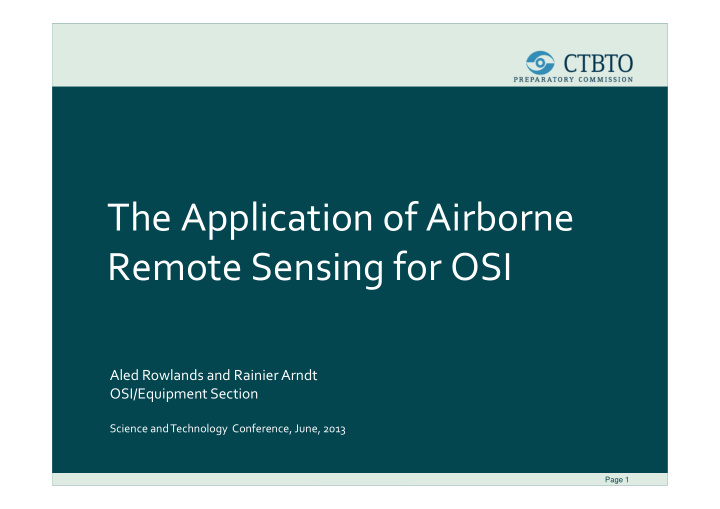



The Application of Airborne Remote Sensing for OSI Aled Rowlands and Rainier Arndt OSI/Equipment Section Science and Technology Conference, June, 2013 Page 1
Structure . Context Expert Meetings Field Tests Sensors Flight Operations Features and Results Data Products Summary Page 2
Context: airborne remote sensing, MSIR “ Visual observation, video and still photography and multi-spectral imaging, including infrared measurements, at and below the surface, and from the air, to search for anomalies or artifacts” Para 69d, Part 2 of the Protocol to the Comprehensive Nuclear Test-Ban Treaty Page 3
Expert meetings: MSEM.11 … identified OSI-relevant observables that could potentially be detected by MSIR technologies but which need to be tested. These included: Page 4
Field tests: sensors Thermal Short-wave Infrared Visible Infrared Thermal SWIR LIDAR VNIR Visible 14-7.5 μm 2.55 – 0.95 μm 1 – 0.4 μm digital camera/video • Vehicle • Context Movements • Fluffing • Anthropogenic • Hydrological • Sub canopy features features changes • Soil properties • Vegetation stress • Water absorption • Anthropogenic features features Page 5
Field test: sensors Visible camera Thermal camera VNIR SWIR Sensor array mounted on the side of Alouette II with GPS and solar sensor at rear. GPS FODIS Page 6
Field tests: locations 1.6 km 2 50km 2 4.9 km 2 Page 7
Field tests: flight planning 1] Flying height above ground level 2] Sun angle (morning, noon, sunset) 1,500m 1,400m 500m 3] Flying direction 250m Page 8
Field tests: flight planning, spatial resolution 24 May @250m, 0.02m 21 May @500m, 0.1m 25 May @1,400m, 0.2m Page 9
Field test: MSFE-11 Spaceborne Airborne and Spaceborne Site Image 1 Ground-based data Image 2 Modifications SPOT (10m) acquisition SPOT (20m) Daily acquisition 15/08/11 18/08 22/08 29/08 05/09 12/09 16/09 19/09 Page 10
Field test: MSFE-12 Spaceborne Airborne and Spaceborne Site Site Worldview 2 Ground-based data Worldview 2 Modifications Modifications Radarsat 2 acquisition Radarsat 2 21-25/05 20-21/04 20/03/12 07-09/05 14-15/05 Page 11
Field test: ground disturbance Aim: assess the extent to which disturbance can be identified and chronology determined Site modification: construction of 5 pits, dug to rock interface at ~weekly intervals then covered; pit 5 remaining exposed 12/09 18/08 22/08 05/09 29/08 Page 12
Field test: vehicle movements Aim: assess the extent to which vehicle type can be distinguished and whether chronology can be inferred • APC tracks tend to 18/08 splay vegetation, 250m grass then dies 22/08 away (turns yellowish) 200m • Tank treads 29/08 expose more soil. 150m • After multiple movements the 05/09 tank treads 100m become much more apparent as 12/09 more soil is 50m exposed. Page 13
Field test: vehicle movements Aerial image Thermal image (visible) Visible image reveals the pits and roads but Thermal image reveals that most recent which part of the road was used most activity has taken place along the southern recently? portion of the access road Page 14
Field test: hydrological change Modifications: • Four loops installed, two for ground temperature water and two for heated water. • One ground water and one heated loop installed with dripping heads. Page 15
Field test: hydrological change 21 May, PM @500m, 0.5m 24 May, AM @500m, 0.5m 24 May, PM @500m, 0.5m Page 16
Field test: fluffing • 96 boreholes • 4.5 – 6 m depth • 6 -8 m spacing • 500 kg of explosives • Charges 2-10kg • 4 boreholes as control • Ripple blasting not possible • Surface acceleration of ~1 g / 9.8 m s -2 Page 17
Field test: fluffing Page 18
Field test: vegetation Heated water dripping loop (25 June, 2012), i.e., a month after water flow Change in ceased during MSFE12. vegetation reflectance detected after blasting Reflectance Page 19
Field test: anthropogenic features Aerial image Lidar reveals (visible) anthropogenic features under the canopy. Page 20
Data products: additional overflight Page 21
Summary • The value of airborne remote sensing for OSI has been demonstrated; • Successfully demonstrated the detection of key signatures but not all; • Feeds into OSI Inspection Team Functionality; • Ability to provide value added products to the OSI Inspection Team e.g., • Context information such as imagery can be viewed on field tablets. • Challenges remain with respect to: • Data handling and automation of processing; • OSI-relevant signatures in different environmental settings. Page 22
Recommend
More recommend